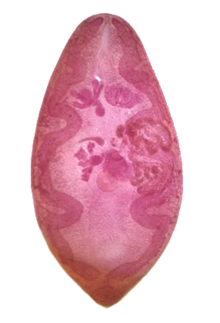
Back جانبية المناسل الفسترمانية Arabic جانبية المناسل الفسترمانيه ARZ Ağciyər sorucusu Azerbaijani Paragonimus westermani Catalan Paragonimus westermani Czech Paragonimus westermani German Paragónimus westermàni EML Paragonimus westermani Spanish کپلک شش Persian Paragonimus westermani French
| Paragonimus westermani | |
|---|---|

| |
| An adult specimen stained with carmine | |
| Scientific classification | |
| Domain: | Eukaryota |
| Kingdom: | Animalia |
| Phylum: | Platyhelminthes |
| Class: | Trematoda |
| Order: | Plagiorchiida |
| Family: | Paragonimidae |
| Genus: | Paragonimus |
| Species: | P. westermani
|
| Binomial name | |
| Paragonimus westermani | |
| Subspecies | |
|
P. westermani filipinus | |
Paragonimus westermani (Japanese lung fluke or oriental lung fluke) is the most common species of lung fluke that infects humans, causing paragonimiasis.[2] Human infections are most common in eastern Asia and in South America. Paragonimiasis may present as a sub-acute to chronic inflammatory disease of the lung. It was discovered by Coenraad Kerbert (1849–1927) in 1878.
- ^ Kerbert C. (1878). "Zur Trematoden-Kenntniss". Zoologischer Anzeiger 1: 271–273. Artis zoo, Koninklijk Zoölogisch Genootschap.
- ^ Haswell-Elkins MR, Elkins DB (1998). "Lung and liver flukes". In Collier L, Balows A, Sussman M (eds.). Topley and Wilson's Microbiology and Microbial Infections. Vol. 5 (9th ed.). New York: Oxford University Press. pp. 507–520. ISBN 978-0340663202.